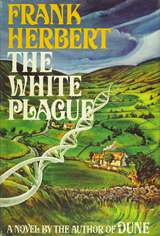The White Plague
 Cover of the first edition | |
| Author | Frank Herbert |
|---|---|
| Cover artist | Abe Echevarria[1] |
| Country | United States |
| Language | English |
| Genre | Science fiction |
| Publisher | G.P. Putnam's Sons |
Publication date | 1982 |
| Media type | Print (hardback & paperback) |
| Pages | 445 pp |
| ISBN | 978-0-399-12721-2 |
| OCLC | 8432222 |
| 813/.54 19 | |
| LC Class | PS3558.E63 W55 1982 |
The White Plague is a 1982 science fiction novel by Frank Herbert.
Plot
When an IRA bomb goes off, the wife and children of molecular biologist John Roe O'Neill are killed on May 20, 1996. Driven halfway insane by loss, his mind fragments into several personalities that carry out his plan for him. He plans a gendercidal revenge and creates a plague that kills only women, but for which men are the carriers. O'Neill then releases it in Ireland (for supporting the terrorists), England (for oppressing the Irish and giving them a cause), and Libya (for training said terrorists); he demands that the governments of the world send all citizens of those countries back to their countries, and that they quarantine those countries and let the plague run its course, so they will lose what he has lost; if they do not, he has more plagues to release.
After releasing the plague, he goes to Ireland to hide, planning to offer his services as a molecular biologist in the hopes of sabotaging whatever work is done there on finding a cure. When he arrives in Ireland, he is suspected of being O'Neill (whom the investigatory agencies of the world have deduced is responsible). To travel to the lab at Killaloe, he is forced to walk with a priest, a boy who has taken a vow of silence due to the death of his mother, and Joseph Herity, the IRA bomber who detonated the explosive that killed O'Neill's wife and children; their purpose is to confirm his identity, either through Herity's indirect questioning, or the possibility that he will confess to the priest when confronted with the pain his revenge has caused for the boy.
Meanwhile, law and order have broken down in England and Ireland, and the old Irish ways are coming back. Local IRA thugs appoint themselves "kings of old", and others recreate ancient Celtic pagan religions centered on the rowan tree. The IRA has effective control of Ireland, but as the governments of the world grow certain that O'Neill is there and essentially in custody, they consider wiping out the three targeted countries to end the lingering threat.
Major themes
Most of the drama is mental, political, and communal. While the story of O'Neill and his revenge is told in full, there is also the larger story of how the governments of the world's countries deal with the plague, which escapes into limited areas that are quickly sterilized by "panic fire", which immolates everything and everyone in it. North Africa is wiped out; Boston is burned to the ground; Rome is destroyed with atomic bombs; and the US pushes for a moat of cobalt dust to isolate Africa, which is written off as a total loss.
The world's armed forces are reorganized under a Canadian Admiral, Francois Delacourt, who heads Barrier Command, responsible for the absolute separation of contaminated and clean areas. Scientists toy with a conspiracy of intellectuals to override the expected repression of research by governments. In countries around the world angry mobs lynch Irish, English, Libyans, and anyone too closely resembling them.
The plague also has major social repercussions. The book implies near the end that polyandry will necessarily become mandatory, potentially giving women involved in such marriages enhanced power.
Awards
The White Plague was nominated for a Locus Award for best science fiction novel in 1983, but lost to Isaac Asimov’s novel Foundation's Edge.[2]
References
- ↑ isfdb
- ↑ »1983 Locus Awards« The LOCUS Index to SF Awards, LOCUS online. Accessed 2011-10-05.